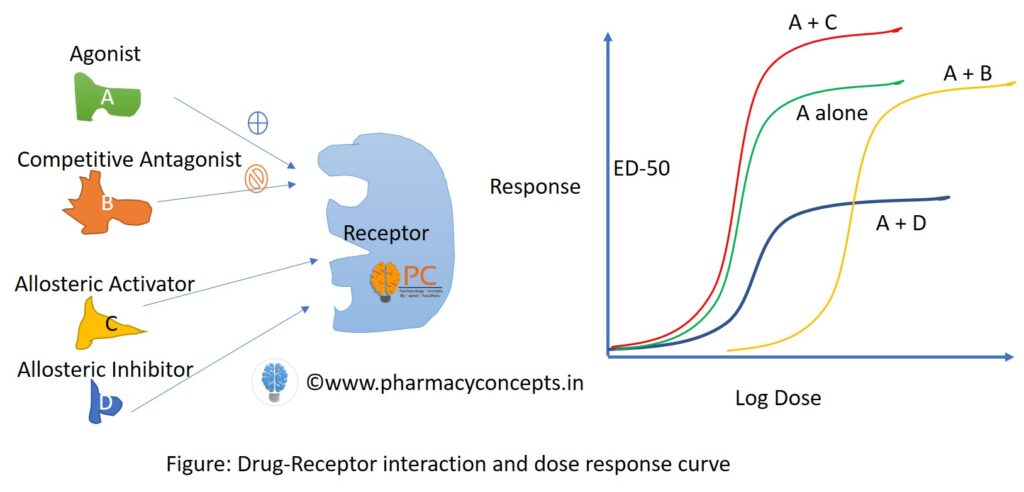Receptor Theories & Dose-Response Relationship
Receptor
The receptor is a macromolecule (mostly protein in nature and some are nucleic acids) having a specific ligand/drug binding site, located at the surface or inside the cells that serve to recognize the signals of ligands and initiate the response, but itself has no other function.
Ligands
The molecules having the affinity for the receptor and may alter the ongoing function. Ligands are generally categorized in to four types based on their affinity (ability to “bind to” the receptor) and efficacy (ability to cause a response via the receptor interaction; intrinsic activity):
- Agonist
- Antagonist
- Partial Agonist
- Inverse Agonist
1. Agonist
The biologically active compounds have the ability to bind with the receptor and activate the receptor to produce an effect similar to the endogenous physiological signaling molecules like neurotransmitters and hormones
- Affinity = 1 (Max)
- Efficacy = 1 (Max)
- Examples: Salbutamol – Beta-2 receptor, Morphine – Opioid receptor, Barbiturates – GABA-A receptor
2. Antagonist (Receptor Antagonist)
The biologically active compounds which prevent the action of an agonist on a receptor by blocking the receptor; means they have the ability to bind with the receptor but do not activate/produce any effect
- Affinity = 1 (Max)
- Efficacy = 0 (Min)
- Examples: Propranolol – blocks the Beta receptor, Prazosin – blocks alfa receptor, Atropine – blocks the muscarinic receptor
Antagonism
Antagonism is the term generally used in opposing the effects like
A) Functional/Physiological Antagonism: opposite action of two agonists that act at different receptors independent of each other but have opposite physiological effects.
- e.g. acetylcholine activates the muscarinic receptor and decreases heart rate, while adrenaline activates the beta receptor and increase the heart rate
B) Competitive Antagonism (most common in clinical practice): An antagonist acts on the same site of the same receptor (only binds) of the agonist, preventing the binding and producing an effect by an agonist. Antagonist binding is reversible and can be overcome by a high dose of agonist.
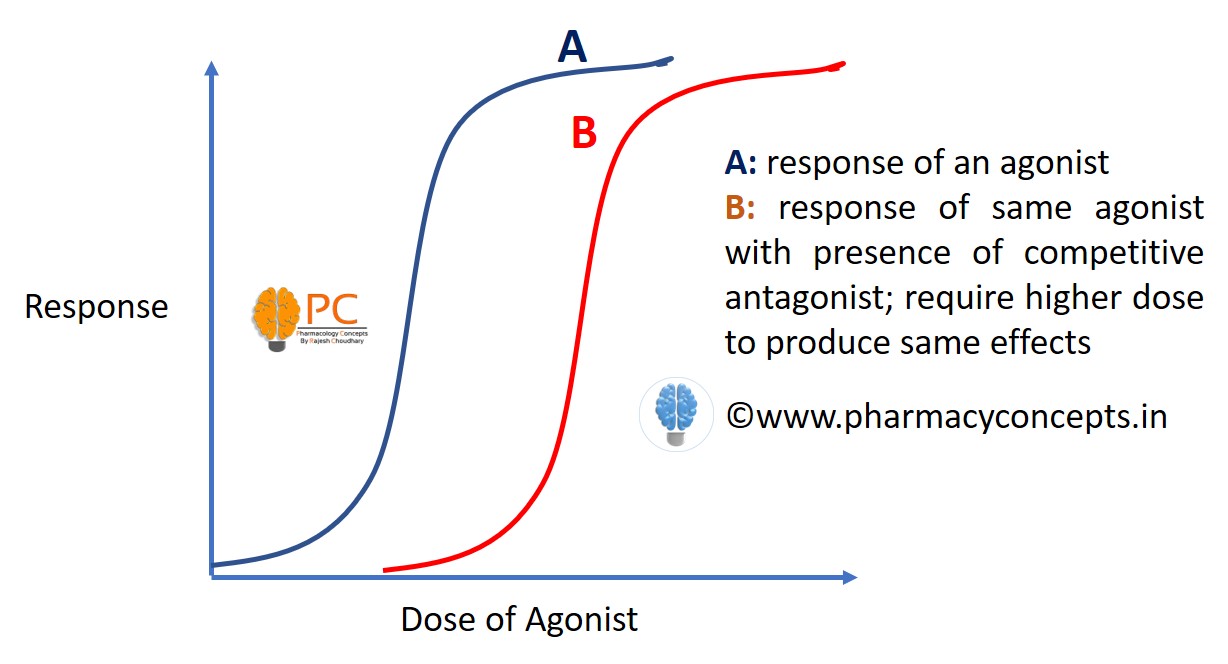
Figure: Dose-response curve of competitive antagonism
C) Non-Competitive Antagonism: An antagonist acts on the allosteric site of the same receptor (only binds) of agonist or irreversible bind with the same site of the same receptor, prevent the binding and or producing an effect by an agonist. Irreversible binding can’t be overcome by a high dose of agonist.
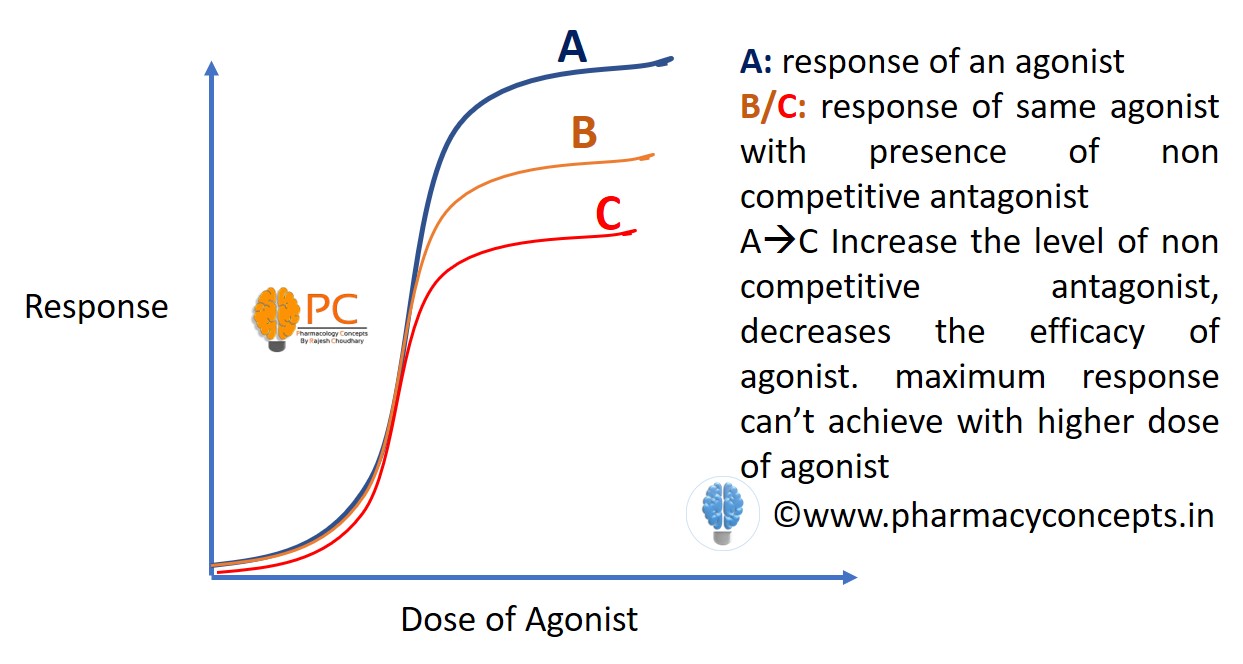
Figure: Dose-response curve of non-competitive antagonism
3. Partial Agonist
The biologically active compounds activate a receptor to produce a submaximal effect.
- Affinity = 1 (Max)
- Efficacy = 0 to 1
- Examples: Buprenorphine – partial agonist for opioid receptor
4. Inverse Agonist
The biologically active compounds bind and activate same receptor as an agonist but produce opposite pharmacological action.
- Affinity = 1
- Efficacy = 0 to -1
- Examples: Beta carboline, DMCM – inverse agonist for GABA-A receptor, Chlorpheniramine – H1 receptor
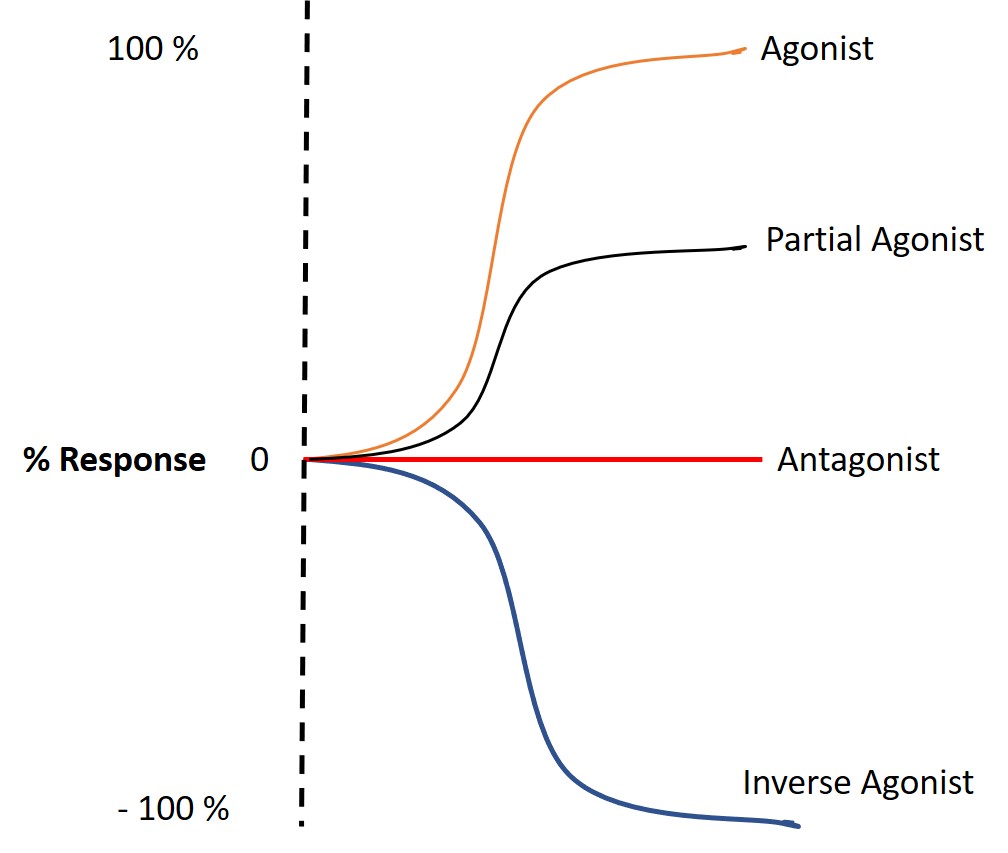
Figure: Response curve of Various Ligands
Receptor Occupation Theory
Research evidence suggested the most of the drugs show specific action through the specific receptor. Receptors are macromolecule, which presents at the cell surface inside the cell and each receptor has a structural specific binding site like a lock for the ligand and the 3D structure of the specific drug molecule (ligand) acts as the key; means stereo-structural specific ligand (drug)-receptor complex (“lock-key model”) may responsible for the biological action of a ligand or drug. Therefore, just like locks and their keys, the interactions between drugs and their targets are highly specific and based on physical shape interactions.
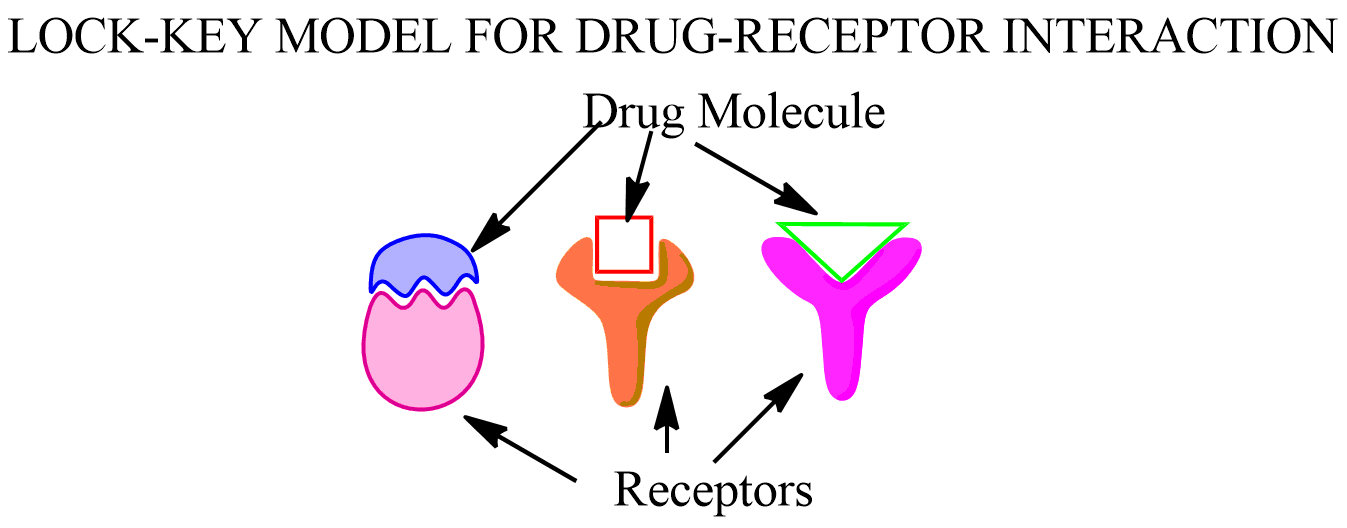
Figure: Lock & Key model of drug-receptor interaction
For example-
- noradrenaline acts on alfa receptor mainly while isoprenaline acts on beta receptor
- levo-noradrenaline is 10 times more potent than dextro- noradrenaline
Clark Theory
In 1937, A. J. Clark Proposed a theory of drug action through receptors based on the occupation of the receptor by a specific drug. He supposed the interaction between to molecules: drug (D) and receptor (R) which govern by the low of mass action, and effects (E) to be a direct action of drug-receptor (DR) complex.
K1
Drug (D) + Receptor (DR) < —–> Drug-receptor complex (DR)àEffects (E)
K2
There are three major observations of the Clark theory-
1) Intensity of the cellular response is directly proportional to the number of receptors occupied; means maximum (100%) response can be achieved when all receptors are occupied.
2) Drug exerts “all or none” action on each receptor. Receptor either fully activated or not at all. No partial activation is based on his theory.
3) Complementary structural feature (Lock & Key Theory)
Later, it has been realized that the occupation of receptor or DR complex is essential but not sufficient to produce action without activation of the receptor. Some drugs have the ability to bind (affinity) and activate the receptor and produce effects (efficacy), they are called agonists while some have only bound with receptors without activation called an antagonist. Some agent binds with receptor but are partially activated and produces a submaximal response called a partial agonist. A theoretical quant (S) denoting the strength of stimulus imparted to the cell was interposed in Clark’s equation
K1
Drug (D) + Receptor (DR) <——-> Drug-receptor complex (DR)àStrength(S)àEffects (E)
K2
Thus, Clark’s theory is partially correct (the first two observation is incorrect) which was proposed by Ariens & Stephenson in the 1950s.
Ariens and Stephenson Theory
1) They observed that adrenaline and histamine could still produce a maximal response when >99% receptors are blocked by a non-competitive antagonist. That means all receptors need not be occupied by the agonist for maximal response. A large receptor reserve exists in their case, or a number of spare receptors are present.
2) Different drugs had different capacities to produce cellular response means some drug partially activates the receptor. That means “all and none” action is not necessary.
3) A receptor cannot be considered to have rigid conformation, because a partial agonist may produce an intermediate degree of conformational change in the receptor.
So based on these theories, the response of a drug depends on strength of activation of the receptor.

Dose-Response Relationship
The dose or concentration-response curve (DRC or CRC) of a drug indicates the response with variable dose. Pharmacodynamic principles measuring efficacy and potency can be quantified using dose-response curves. In general, gradual dose-response relationships of the drug reflects the number of receptors that are effectively occupied. DRC generally showed between response and log dose of a drug over the response vs dose because (i) a wide range of drug doses can be easily displayed on a single graph and (ii) Comparison between agonists and study of antagonists becomes easier.
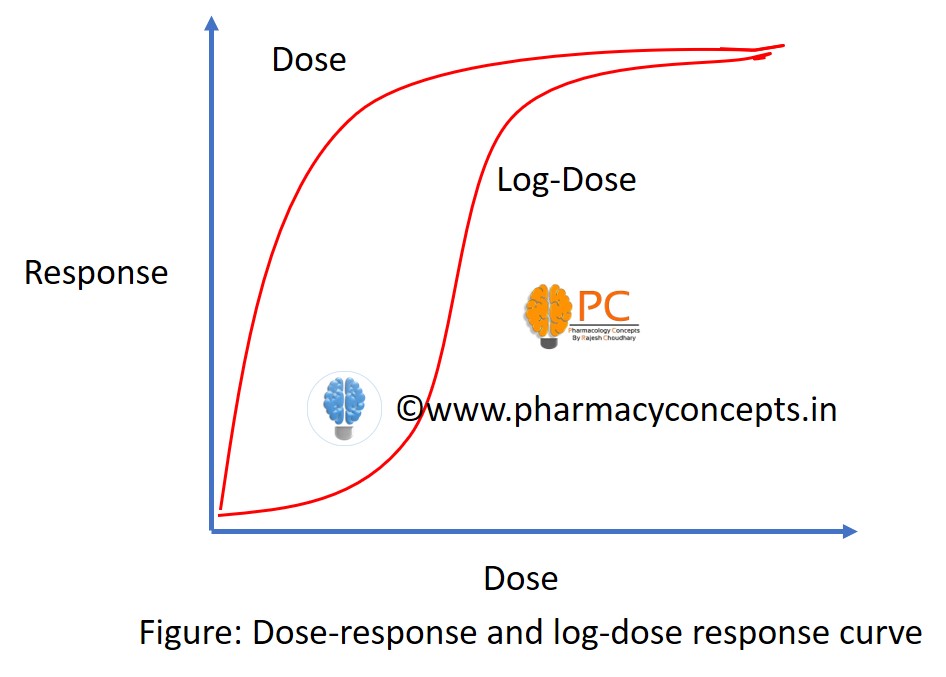
There are two major terms: efficacy and potency, which need to be explained for a better understanding of the importance of the dose-response curve.
Efficacy:
- Efficacy indicates the maximum intensity of response to a drug, eg. if the intensity of drug A is higher than drug B, then drug A is more efficacious than drug B
- ED50 (effective dose-50%) is the dose or drug that gives rise to the designated response in 50% of the subjects or produced a 50% response. ED50 is easier to measure than maximum effect and is used to determine the efficacy
- Similar to ED-50, IC-50 (inhibitory concentration-50%), LD-50 (Lethal dose-50%) are also determined by the dose-response curve.
Potency:
- The term potency is generally used to a comparison of ED50 of two or more drugs that have parallel log dose-response curves
- The drug that reaches the ED50 at the lower dose is the more potent
- Potency is a term that is often misused (confused with efficacy). Potency is not important if you can increase the dose of the less potent drug without causing side effects
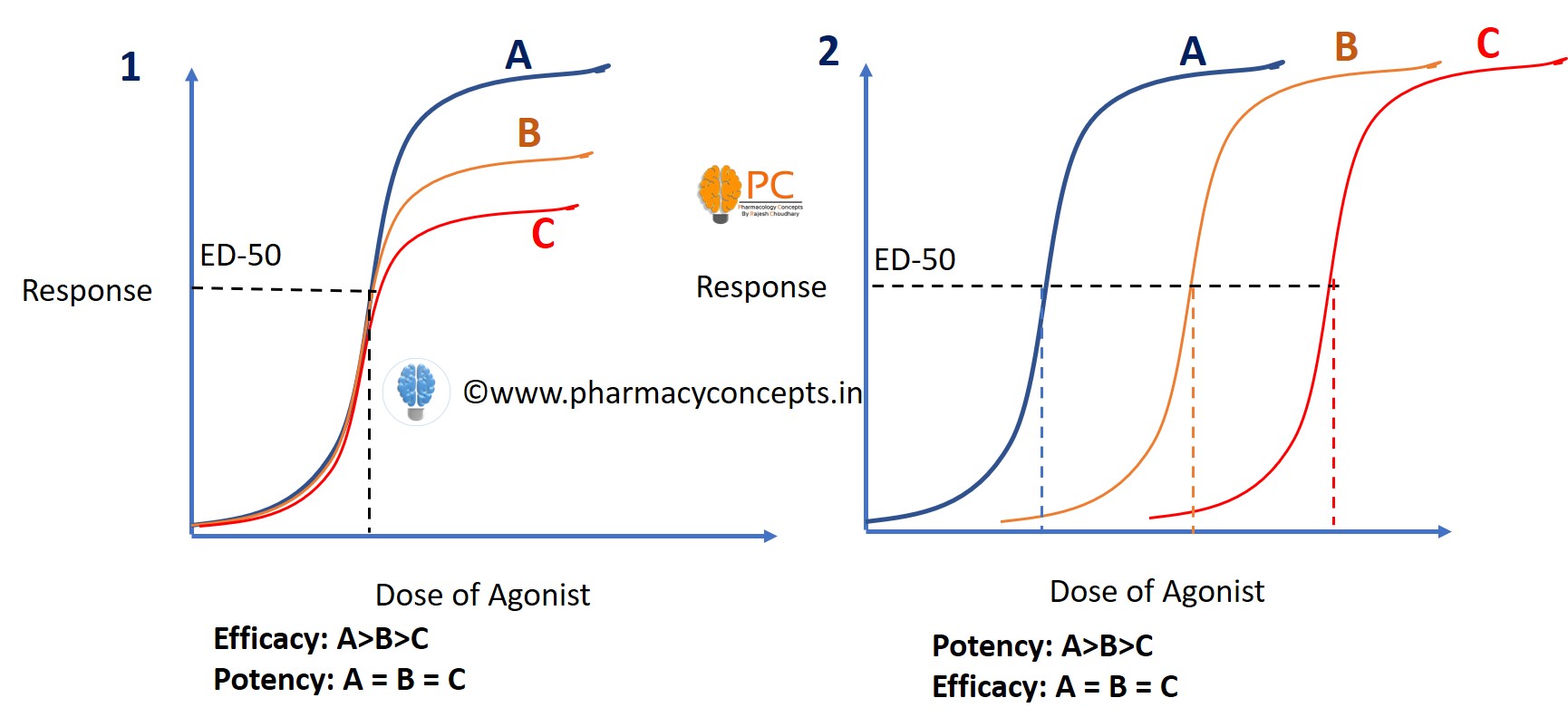
Figure: Dose-response curve explains the efficacy and potency

